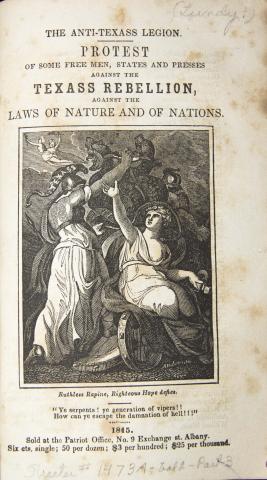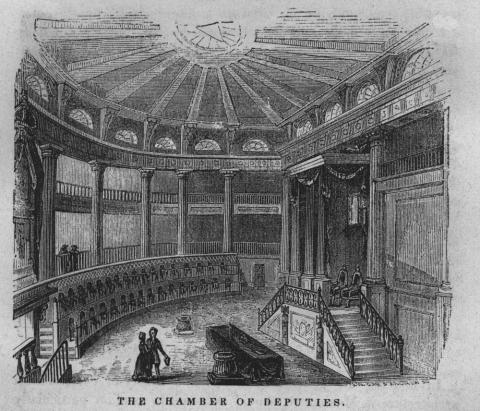The war revealed deep divisions in the political fabric of the United States and Mexico. Although both countries had established republics following their independence from European powers, each had developed political systems that made it difficult for national leaders to prosecute a war effectively. In Mexico, power remained exclusively in the hands of the so-called hombres de bien (men of property). In the United States, by contrast, a democratic two-party system had emerged that purported to represent the interests of adult white male citizens. But whether sovereignty was concentrated in the hands of the few or the many, those in power on both sides of the Rio Grande were obliged to deal with fierce opposition to their policies throughout the conflict.
In Mexico, two broad political factions had fought for political control since the passage of the Constitution of 1824: liberal federalists, who supported self-government for the states, and conservative centralists, who sought to keep power in the hands of elites in Mexico City. Conservative efforts to abolish the constitution in the mid-1830s had brought the republic to the verge of anarchy. The threat of invasion by the United States a decade later, far from uniting Mexican elites in a common cause, only increased the level of political infighting. The federalist government of José Joaquín Herrera collapsed amid rumors that it was negotiating with the United States to resolve the Texas annexation issue. The conservative government of Mariano Paredes y Arrillaga proved no less stable, and was soon replaced in a matter of months by a new federalist government headed by José Mariano Salas. In the end, the only leader capable of holding these disparate factions together was Mexico's pre-eminent caudillo, Antonio López de Santa Anna, who returned from exile in Havana in August, 1846. One month later he assumed the presidency in Mexico City.
Santa Anna preferred battlefield laurels to the day-to-day business of running a country, however, and quickly stepped down to take control of the army. No sooner had he done so than the political infighting broke out anew. When federalists attempted to requisition Church property to help finance the war effort, conservative factions in Mexico City rose up in rebellion. With U.S. troops occupying northern Mexico, and another army under Winfield Scott preparing to seize the port of Vera Cruz, the capital’s National Guard ignited the so-called Polkos Revolt in the early months of 1847.
Although Santa Anna managed to quell the revolt soon after engaging Zachary Taylor’s army at Buena Vista, the squabbling among Mexican political leaders continued in the months that followed. Santa Anna was the object of bitter recriminations as U.S. troops converged on the nation's capital in the summer of 1847. Although some form of negotiated peace now appeared inevitable, no faction was willing to assume responsibility for initiating peace talks. Angry delegates frequently boycotted the sessions of the Mexican Congress, making it impossible for the government to deal with the crisis for lack of a quorum.
In the United States, the war posed very different but equally formidable challenges. Although the outbreak of hostilities was greeted in Washington with patriotic fervor, it would soon become apparent that Polk did not have the full support of the American people. Less than two years earlier, he had won one of the closest presidential elections in U.S. history. Even more problematic, his narrow victory against Whig challenger Henry Clay masked broad dissatisfaction among some members of his own party, who had backed his candidacy in 1844 only grudgingly. Many northern Democrats, supporters of Martin Van Buren, believed their candidate had been robbed of the nomination. In addition, they were becomingly increasingly convinced that the president’s underlying motive in waging war with Mexico was to acquire more territory for slavery, a goal they strongly opposed.
As a result, the pro-war hysteria that gripped Washington in May, 1846 proved to be short-lived. When the president asked Congress for a special discretionary fund (the Two Million Dollar Bill), which Polk hoped could be used as a down payment toward the purchase of New Mexico and California, the request revived the debate about the administration’s war aims. Northern Whigs and Democrats alike charged that the bill would enable the administration to acquire new lands for the expansion of slavery. Pennsylvania Democrat David Wilmot, once a loyal party member, attached a proviso to the bill that would prohibit the peculiar institution in any territory acquired from Mexico. Although the bill failed to pass, the Wilmot Proviso would gain support among northern Democrats troubled by the expansion of slavery.
Whig opposition, though muted when the war was declared, quickly became louder, despite the victories won by U.S. generals in Mexico. Partisanship had much to do with the Whig campaign to obstruct the administration’s war goals (See Partisanship and the U.S. War Effort). But Whig opposition was also fueled by antislavery principles. In the elections to the 30th Congress in 1847, the Whigs picked up 37 seats in the House elections, most in the Northeast and Northwest, to give them a majority in that chamber. When Congress reconvened in December, 1847, Polk faced the very real fear that the House of Representatives would now seek to end the war by cutting off military appropriations. The critics of the administration included Abraham Lincoln, a freshman Whig representative from Illinois. In his first speech, Lincoln presented a set of resolutions condemning the war as unnecessary and unconstitutional. The resolutions became known as the "spot" resolutions, because Lincoln demanded to know the exact spot where American blood had been spilled.


![[Brother Jonathan carving up the pie of Mexico]](/usmexicowar/sites/usmexicowar/files/styles/large/public/2022-11/usmw-GA44_26-91012.jpg?itok=oQJ_FFhj)






